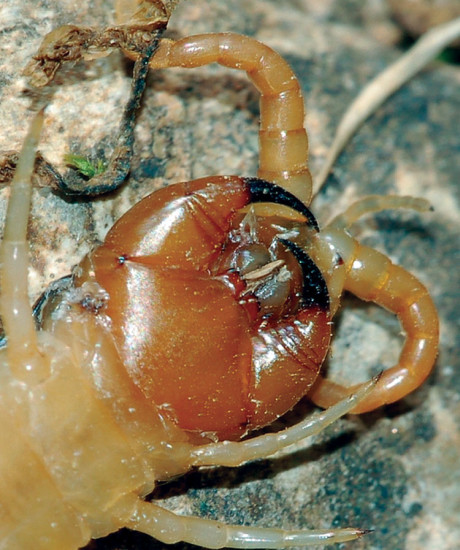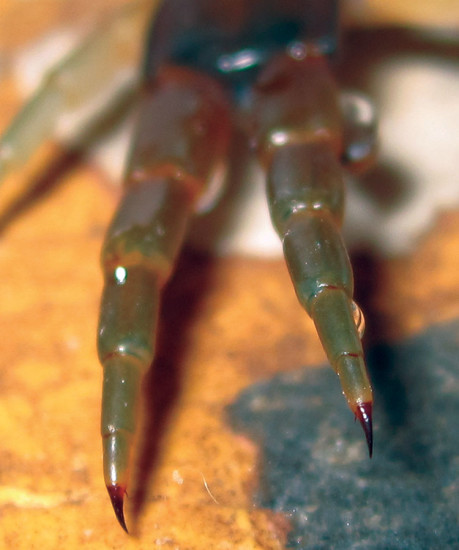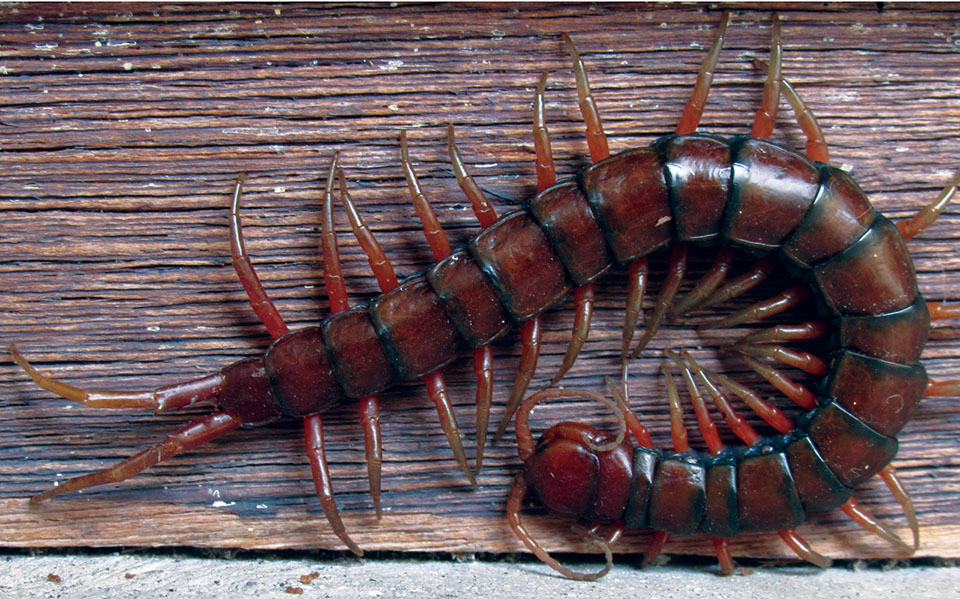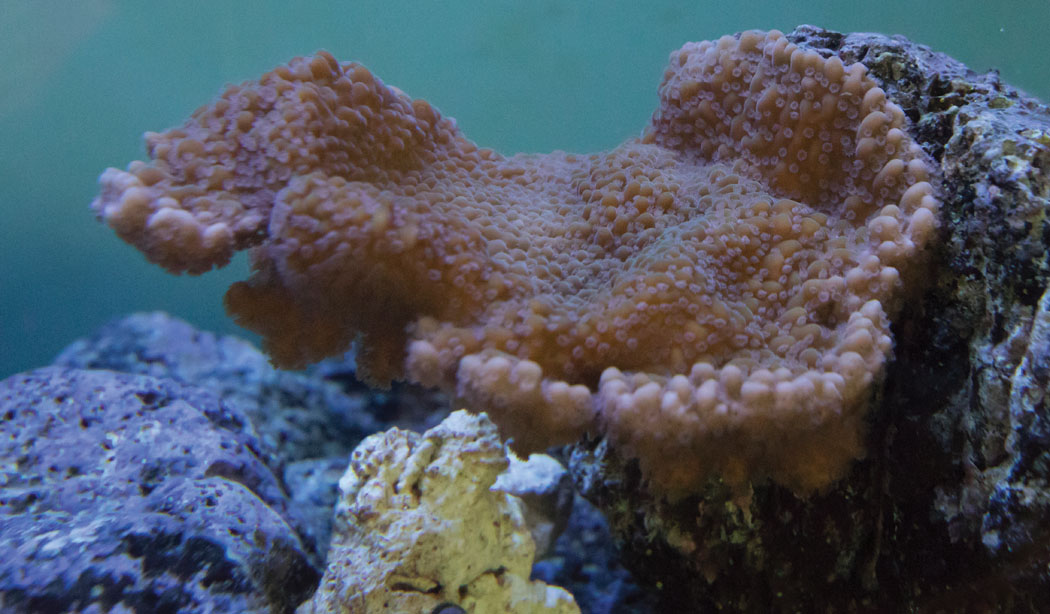All Creatures Great and Small: Centipedes

By Stig Lindholm
Off-island and rooting around in an English garden, my heart skipped a beat when turning over a rock I happened upon a centipede. Then, with surprised relief, I realized that an encounter with the British Isles’ cousin of the Hawai‘i centipede is, without question, far less exciting.
I spent my childhood growing up on an island in the Mediterranean and was reminded of those times and the intrigue children have for all things living—particularly small creatures that walk, crawl, or squirm. Compelled by that intrigue, I recollect my excitement corralling a scorpion into a matchbox. I do not, however, recall any degree of trepidation. It was what children did—I think. Incidentally, after successfully accomplishing the roundup, the scorpion was returned safely to its habitat.
In 1848 Irish born poet, Cecil Frances Alexander wrote the lyrics to the hymn, “All Things Bright and Beautiful,” in which the first verse and chorus goes:
All things bright and beautiful,
All creatures great and small,
All things wise and wonderful,
The Lord God made them all.
The hymn appeared as one of a collection of verses in a book, Hymns For Little Children, and aside from its religious connection it is, generally, how young children experience the world and everything in it.

As we grow older, we learn more—usually from the elder and supposedly wiser—and together with that knowledge we often become attached to phobias regarding things we needn’t necessarily be concerned about. Those phobias rub off on us consciously or subconsciously, and however unconcerned we pretend to be, living in Hawai‘i can alter one’s perspective of small creatures with legs. Like my former island home, Hawai‘i has scorpions, yet it is the centipede that troubles Hawai‘i residents most—probably more so than anything that swims in the ocean.
In his collection of short stories, Stories of Hawai‘i, Jack London devotes several paragraphs to a disturbing encounter with a Hawai‘i centipede—“the ugly venomous devil.”
“The centipede, seven inches of squirming legs, writhed and twisted and dashed itself about his hand, the body twining around the fingers and the legs digging into the skin and scratching as the beast endeavored to free itself. It bit him twice.”
As horrific as that sounds, when considering all creatures great and small, in particular those that live in the coastal waters surrounding Hawai‘i, and consequently our rather tenuous existence, the centipede is fairly insignificant. Knowing a little more about the centipede won’t necessarily make it less troublesome. At least we’ll know where it’s coming from and about the many legs on which it arrives.
Centipedes (the name acquired from the Latin “centi-pedere,” meaning “hundred foot”) belong in the class Myriapoda, which is defined as an arthropod having an elongated segmented body with numerous pairs of jointed legs. They are metameric creatures with one pair of legs per body segment. Indifferent to its Latin name, centipedes may have less than 100 legs, or many more. How ever many they do have, they always have an odd number of pairs; therefore, as close as we can get to the Latin translation would be either 98 “foot” or 102.

Myriapods have been around for more than 400 million years; as a species they are older than Homo sapiens and the Hawaiian islands themselves.
Myriapods (or centipedes) have a single pair of antennae to sense their way around as most don’t have eyes, and those that do, don’t see very well. The mouthparts lie on the underside of the head consisting of a labrum forming the upper lip, a pair of maxillae forming the lower lip, and a pair of mandibles located inside the mouth. They breathe through spiracles (open holes close to the bases of their legs) that connect to a tracheal system. They have a long tubular heart that extends through much of the body and have few connecting blood vessels.
The reproduction process involves the male producing a packet of sperm that is transferred to the female externally. The female lays eggs under rocks or bark or in any dark, damp, cool place. She is protective of her eggs, which eventually hatch into shortened versions of the adult with only a few segments and as little as three pairs of legs or into fully formed juvenile centipedes. The young that are not hatched fully-formed add additional segments and limbs as they molt into adult size and continue to grow throughout their lives of between three and five years. Research suggests that some centipedes may live as long as 10 years, which would account for the reports of giants, as with each successive molt, centipedes grow.
Myriapoda is further categorized into four subclasses. One of those subclasses is named Chilopoda and is of particular interest to the anxious amongst us. It is the class of Myriapoda that specifically includes the species of centipedes whose front pairs of legs have evolved into jaws capable of dispensing venom. Our anxiety may be fostered from having been bitten, knowing someone who has, or we have heard enough about the experience to be anxious in any case. And for new arrivals to this Pacific paradise and innocent of the notion, then after reading this and looking at the pictures, there’s a good chance you’ll begin to share in everyone else’s anxiety.

Those centipedes (in the subclass Chilopoda) most commonly stumbled upon in Hawai‘i are further subcategorized in to four classes: stone centipedes, snail centipedes, house centipedes, and tropical centipedes. It is the fourth category that perpetuates angst—Scolopendromorpha. Unlike actual house centipedes, tropical centipedes—that are also found in houses—have thicker, shorter legs and can grow to an alarming size. We hear stories of encounters with some giants, and indeed, in other tropical countries, sizes of Scolopendromorpha reaching 18 inches have been recorded.
In Hawai‘i though, large centipedes scurry in around six inches with occasional reports of eight inches, which is big enough in my book.
Of the Scolopendromorpha encountered in Hawai‘i Scolopendra subspinipes is the largest and most daunting. Adults have 21 body segments and are a reddish-brown color with yellow-orange legs. They are strong and resilient wrapping themselves around prey, their grip assisted by small spines on their legs and the rear-most pair of legs possessing sharp claws. Venom in glands is injected through the front pair of legs that have evolved into small jaws. The spines on their rear legs are sharp enough to scratch skin. In addition to venom-glands, centipedes have other glands that in defense of attack secrete a noxious substance onto their legs that can enter human skin through the scratches left by the claws and result in a trail of red swollen skin.
At this point, it might be appropriate for some preventative advice—methods of deterring the centipede and ways of eradicating it.
Well, I don’t have any.
The centipede is here to stay, and living in Hawai‘i—at least on the warm and tropical lower lands—you will eventually encounter one and likely more than just one.
There are probably a few old wives tales floating around and an arsenal of toxic options that would, along with killing the centipede, simultaneously kill everything else.
It is worth noting that, if you are previously accepting of the use of poisons, in Hawai‘i, for ecological reasons and just common sense, poison is not the best choice.
The old wives thing is probably alright, and there are natural measures that involve simple common sense. Generally speaking, it’s a case of being observant and hoping for the best.
Centipedes lose body moisture through their spiracles and prefer damp, cool, moist habitats, such as leaf piles or beneath piles of other garden debris and under rocks. I have heard of Puna residents in the rainy southeast corner of the island wrapping their bed legs in silver foil to prevent an assault from ground level and even suspending beds above the ground from chains hanging from the ceiling. On that count, it’s worth mentioning that Jack London’s centipede didn’t crawl up from the ground and onto someone.
It dropped from the rafters of the lānai.
I suppose then, when in Hawai‘i, we might consider centipedes coming at us from all directions. Yet, in fact—not that this will be in any way consoling—centipedes don’t actually come at you. Although fierce nocturnal predators of other small creatures, they are frightened of human encounters and only bite in defense.
There—you see—nothing to worry about.

While there are no records of a human dying as a direct result of a centipede bite, one might complicate a preexisting medical condition and its effect will depend on the individual’s tolerance to the venom and where on the body the bite occurs.
In Jack London’s tale, the gallant Jack Kersdale, who calmly removed the centipede from Dottie Fairchild’s hair, was bitten twice on his arm, which despite almost immediate medical attention swelled to some size; it “was as big as a barrel, and it was three weeks before the swelling went down.”
Considering the centipede’s preference to moist habitat, it would therefore be wise to remove any of those from the proximity of homes. Keep the yard—at least the area around the house—clean, including the space beneath the house.
It goes without saying, for centipedes and for all scavenging creatures that the insides of houses should also be kept clean. And consideration given to likely points of entry—under and around screen doors and via drainage pipes. It’s not uncommon for centipedes to appear through open plugholes, which can be a surprise in the bathroom.
Once inside the home, centipedes will seek out dark places to hide—inside shoes, amongst piles of clothes left on the floor, and unfortunately, in our beds. Again, it’s a case of being tidy, vigilant, and hoping for the best.
You might know already, or will eventually find out, that centipedes can move along at an unnerving speed. Given our propensity as humans to trip over just one pair of legs, centipedes have a remarkable system of coordinated propulsion.
Each of the centipedes’ segments are joined by flexible membranes that allow them to travel over uneven surfaces while simultaneously altering the length of their stride to speed up or slow down. In addition, each pair of legs is slightly longer than the pair in front, so stepping forward doesn’t involve the following legs tangling with those ahead. Unfortunately, as marvelous as this feat is, it does not save the centipede from capture and the chopping block.
After encountering and capturing a centipede, the common method of dispatch is by chopping it up into small pieces, usually an exciting and messy business. Clubbing a centipede with a slippah is pretty much useless. Some island residents keep a chopping board and knife specifically for the execution or a pair of heavy-duty kitchen scissors. I opt for a more humane approach.
My preference for not killing centipedes doesn’t come from any religious or morale high ground, just karma—I suppose. I reckon that if I return a housebound centipede to the outdoors, or I let any I find outdoors go about their general business of attempting to flee, then, in some future time, themselves or their relatives might not bite me. It’s worked out for the best so far, for them and me. My centipede equipment consists of a long handled dustpan and brush. In a quiet house with a hard floor it’s possible to hear the larger centipedes scratching along. Then, much as I did with my childhood scorpion, it is as simple as brushing the corralled centipede into the pan and returning it to the outdoors.
Well almost.
During the transition you have to keep the pan at an angle and shake it a little, otherwise, eventually, the centipede manages to crawl up the slippery plastic surface of the pan and escape. Although I have never been on first name terms with any of the centipedes I have met, I’m pretty sure that I have come across the same character more than once.
My last and closest encounter with a centipede was during the night while I was asleep in bed. I woke up to the sound and feel of scratching across the sheet. Fortunately it was across the top of the top sheet and not under. Then, simultaneously, I saw the silhouette in the moonlit room and felt the weight of it on my body. I didn’t hang around for any more of the experience and throwing the sheet aside ran for the closet, pan, and brush.

When we hear stories of the sizes of some centipedes, we might doubt their validity. That said, I’m happy to be conservative with the estimate of the size of the centipede I encountered that night and say it was between six and eight inches long and perhaps up to an inch in diameter; notwithstanding a previously excellent dustpan technique this centipede managed to crawl out of the pan three times before we made it outdoors.
“What good do they do?” is often the question that we ask of the less desirable creatures with which we share the planet. Well, they help with breaking down leafmould, which in a forest environment helps the tree. There might be more, but I don’t see that what the centipede does or doesn’t do really matters as the question is usually put from the human perspective of “What good does the centipede do for us—humans?” We are here to share the planet with them so we might as well get on with doing that and be more accepting of them and banish any phobias we might have.
Given the time centipedes have existed here on the planet, they must be getting something right, and for that achievement alone they are quite remarkable.
Hawai‘i is paradise for all God’s creatures, great and small, although it is easier to recite the verse from the relative safety of a temperate English garden. ❖
Contact writer Stig Lindholm: stig_lindholm@mac.com


